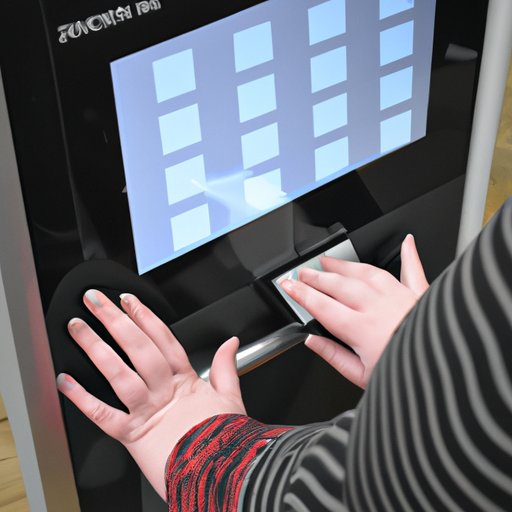Introduction
Assistive technology is an umbrella term used to describe any device or system that helps individuals with disabilities or impairments complete everyday tasks. Assistive technology can make a huge difference in the lives of people with physical, sensory, or cognitive impairments by providing them with increased independence and autonomy. This article will explore the definition, benefits, types, cost, and trends in assistive technology.
Definition of Assistive Technology
The American Disabilities Act (ADA) defines assistive technology as “any item, piece of equipment, or product system, whether acquired commercially off the shelf, modified, or customized, that is used to increase, maintain, or improve functional capabilities of individuals with disabilities.” In other words, assistive technology is designed to help people with disabilities or impairments perform tasks that they may otherwise be unable to do without assistance.
Overview of Benefits
Assistive technology can provide a wide range of benefits to individuals with disabilities or impairments. These benefits include improved independence and autonomy, enhanced quality of life, improved educational experiences, and increased access to employment opportunities. Additionally, assistive technology can help reduce the amount of time and effort it takes to complete certain tasks, making life easier for both the user and their caregivers.
Types of Assistive Technology
There are many different types of assistive technology available, and each type is designed to meet the specific needs of its users. Some of the most common types of assistive technology include:
Mobility Aids
Mobility aids such as wheelchairs, walkers, and scooters can help individuals with physical impairments increase their mobility and independence. These devices can also help reduce the risk of falls and injuries.
Visual Aids
Visual aids such as magnifiers, reading glasses, and low-vision aids can help individuals with vision impairments see more clearly. Additionally, closed captioning devices and screen readers can help individuals with hearing impairments access audio content.
Hearing Aids
Hearing aids such as cochlear implants and personal amplifiers can help individuals with hearing impairments hear more clearly. Additionally, assistive listening devices can help individuals who are hard of hearing communicate more effectively in noisy environments.
Communication Aids
Communication aids such as voice recognition software, text-to-speech software, and augmentative and alternative communication (AAC) systems can help individuals with speech impairments communicate more effectively. These devices can also help individuals with cognitive impairments express themselves more clearly.
Cognitive Aids
Cognitive aids such as memory aids, organization tools, and task reminders can help individuals with cognitive impairments remember important information, stay organized, and complete tasks on time. Additionally, assistive technology can help individuals with cognitive impairments stay safe by providing reminders about safety protocols.
Quality of Life
Assistive technology can help enhance the quality of life for individuals with disabilities or impairments. By providing individuals with increased independence and autonomy, assistive technology can help individuals feel more confident and empowered. Additionally, assistive technology can help reduce the amount of time and effort it takes to complete everyday tasks, allowing individuals to focus their energy on activities that bring them joy.
How Assistive Technology Enhances Quality of Life
Assistive technology can provide a variety of benefits that can help improve quality of life, such as increased mobility, improved communication, better organization, and increased safety. For example, wheelchair ramps and elevators can help individuals with mobility impairments access public spaces more easily. AAC systems can help individuals with speech impairments communicate more effectively. Memory aids can help individuals with cognitive impairments stay organized and on track. And task reminders can help individuals with cognitive impairments stay safe by providing reminders about safety protocols.
Examples of Improved Quality of Life
Assistive technology can have a profound impact on the quality of life for individuals with disabilities or impairments. For example, a study conducted by the University of Glasgow found that assistive technology had a positive effect on self-esteem, autonomy, and overall wellbeing among participants with physical disabilities. Another study published in the journal Disability and Rehabilitation found that individuals with hearing impairments who used hearing aids experienced improvements in quality of life, communication, and self-confidence.
Education
Assistive technology can also have a positive impact on educational experiences. Assistive technology can help students with disabilities or impairments access educational materials more easily and participate more fully in the classroom. Additionally, assistive technology can help reduce the amount of time and effort it takes to complete assignments and tests, allowing students to focus more of their energy on learning.
Impact of Assistive Technology on Education
Assistive technology can make a significant difference in the educational experience for students with disabilities or impairments. For example, voice recognition software can help students with speech impairments speak more clearly and confidently in class. Text-to-speech software can help students with vision impairments read course materials more easily. And cognitive aids such as task reminders and organization tools can help students with cognitive impairments stay on track and complete assignments on time.
Examples of Improved Educational Experiences
Assistive technology can have a profound impact on the educational experiences of students with disabilities or impairments. For example, a study published in the journal Computers & Education found that students with physical disabilities who used assistive technology experienced improvements in academic performance and attitudes towards school. Additionally, a study published in the journal International Journal of Inclusive Education found that students with hearing impairments who used hearing aids experienced improvements in language and literacy skills.
Cost of Assistive Technology
One of the biggest barriers to access for individuals with disabilities or impairments is the cost of assistive technology. Many assistive technology devices can be expensive, and not all individuals can afford to purchase these devices out of pocket. Fortunately, there are a number of funding options available to help individuals cover the cost of assistive technology.
Financial Considerations
When considering the cost of assistive technology, it is important to keep in mind that the initial cost of the device is often only the beginning. Many assistive technology devices require ongoing maintenance and repairs, which can add to the total cost over time. Additionally, some assistive technology devices require specialized training, which can also add to the cost.
Funding Sources for Assistive Technology
Fortunately, there are a number of funding sources available to help individuals cover the cost of assistive technology. For example, many insurance plans, including Medicare and Medicaid, provide coverage for some types of assistive technology. Additionally, some states offer financial assistance programs specifically for assistive technology. Finally, many charitable organizations provide grants and scholarships to help individuals cover the cost of assistive technology.

Making Assistive Technology More Accessible
In order to make assistive technology more accessible, it is important to focus on increasing awareness and understanding of the benefits of assistive technology, as well as reducing the cost of these devices. Additionally, it is important to ensure that individuals have access to the resources needed to find and use assistive technology.
Strategies for Increasing Accessibility
In order to make assistive technology more accessible, it is important to focus on increasing awareness and understanding of the benefits of these devices. This can be done through outreach efforts such as community meetings, workshops, and seminars. Additionally, it is important to reduce the cost of assistive technology by increasing the availability of funding sources and exploring strategies such as shared ownership models.
Programs for Increasing Accessibility
There are a number of programs designed to increase accessibility to assistive technology. For example, the Assistive Technology Loan Program provides low-interest loans to individuals with disabilities or impairments to help them cover the cost of assistive technology. Additionally, the Assistive Technology Exchange program allows individuals to donate or loan assistive technology devices to others in need. Finally, the Access to Telework program provides grants to employers to help them purchase assistive technology for their employees.
Trends in Assistive Technology Development
Assistive technology is continually evolving to meet the needs of individuals with disabilities or impairments. Recent developments in assistive technology have focused on increasing the portability, usability, and affordability of these devices. Additionally, advances in artificial intelligence and machine learning are paving the way for new types of assistive technology that can provide more personalized assistance.
Latest Developments in Assistive Technology
Recent developments in assistive technology have focused on increasing the portability, usability, and affordability of these devices. For example, wearable devices such as smart watches and fitness trackers can help individuals with physical impairments monitor their health and activity levels. Additionally, voice recognition software and natural language processing systems are making it easier for individuals with speech impairments to communicate more effectively.
Future Directions for Assistive Technology
Advances in artificial intelligence and machine learning are paving the way for new types of assistive technology that can provide more personalized assistance. For example, AI-powered virtual assistants can provide real-time guidance and support to individuals with cognitive impairments. Additionally, AI-powered robots can provide physical assistance to individuals with mobility impairments. Finally, advancements in 3D printing technology are making it easier to create custom assistive technology devices at a lower cost.
Conclusion
Assistive technology can make a huge difference in the lives of individuals with disabilities or impairments. This article has explored the definition, benefits, types, cost, and trends in assistive technology. Assistive technology can provide a variety of benefits, such as improved independence and autonomy, enhanced quality of life, improved educational experiences, and increased access to employment opportunities. Additionally, recent developments in assistive technology have focused on increasing the portability, usability, and affordability of these devices. With the right resources and support, assistive technology can help individuals with disabilities or impairments lead fuller and more independent lives.
Summary of Benefits
Assistive technology can provide a wide range of benefits to individuals with disabilities or impairments, including improved independence and autonomy, enhanced quality of life, improved educational experiences, and increased access to employment opportunities. Additionally, recent developments in assistive technology have focused on increasing the portability, usability, and affordability of these devices.
Resources for Further Information
For more information on assistive technology, visit the following websites:
- Disability.gov: Assistive Technology
- ATIA: Assistive Technology Industry Association
-
(Note: Is this article not meeting your expectations? Do you have knowledge or insights to share? Unlock new opportunities and expand your reach by joining our authors team. Click Registration to join us and share your expertise with our readers.)
